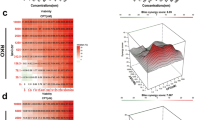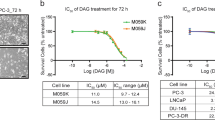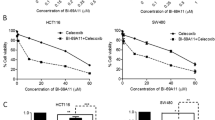Abstract
The concept to fight against tumour resistance is to use chemosensitizers that selectively sensitize tumour cells to chemotherapeutic drugs without affecting normal tissue. In this study, the chemosensitizing potential of a novel benzoxazine derivative in combination with Doxorubicin, a DNA damaging chemotherapeutic drug was evaluated. The results of this study showed that the compound LTUR6 is a potent chemosensitizer of Doxorubicin in colon cancer cell lines, HCT116 and HT29. It was also observed that LTUR6 delayed the resolution of Doxorubicin-induced γH2AX, a specific marker of unrepaired DNA DSB, and prolonged cell cycle arrest in both cell lines. This eventually led to DNA fragmentation, caspase activation and ultimately apoptosis in LTUR6 treated cell lines. Results of western blot analysis revealed that LTUR6 significantly inhibited the phosphorylation of DSB repair enzyme AKT, in response to Doxorubicin-induced DSB. We propose that the chemosensitization observed following inhibition of PI3K is likely due to the involvement of a number of downstream targets of AKT.







Similar content being viewed by others
References
Ferlay J, Shin HR, Bray F, Forman D, Mathers C, Parkin DM (2010) Estimates of worldwide burden of cancer in 2008: GLOBOCAN 2008. Int J Cancer 127(12):2893–2917. doi:10.1002/ijc.25516
Lupertz R, Watjen W, Kahl R, Chovolou Y (2010) Dose- and time-dependent effects of doxorubicin on cytotoxicity, cell cycle and apoptotic cell death in human colon cancer cells. Toxicology 271(3):115–121. doi:10.1016/j.tox.2010.03.012
Watson JL, Hill R, Lee PW, Giacomantonio CA, Hoskin DW (2008) Curcumin induces apoptosis in HCT-116 human colon cancer cells in a p21-independent manner. Exp Mol Pathol 84(3):230–233. doi:10.1016/j.yexmp.2008.02.002
Ravizza R, Gariboldi MB, Passarelli L, Monti E (2004) Role of the p53/p21 system in the response of human colon carcinoma cells to Doxorubicin. BMC Cancer 4:92. doi:10.1186/1471-2407-4-92
Nitiss JL (2009) Targeting DNA topoisomerase II in cancer chemotherapy. Nat Rev Cancer 9(5):338–350. doi:10.1038/nrc2607
Bartlett EJ, Brissett NC, Plocinski P, Carlberg T, Doherty AJ (2016) Molecular basis for DNA strand displacement by NHEJ repair polymerases. Nucleic Acids Res 44(5):2173–2186. doi:10.1093/nar/gkv965
Hao C, Shao R, Raju U, Fang B, Swisher SG, Pataer A (2016) Accumulation of RNA-dependent protein kinase (PKR) in the nuclei of lung cancer cells mediates radiation resistance. Oncotarget 7(25):38235–38242. doi:10.18632/oncotarget.9428
Cantley LC (2002) The phosphoinositide 3-kinase pathway. Science 296(5573):5573. doi:10.1126/science0.1655
Martini M, De Santis MC, Braccini L, Gulluni F, Hirsch E (2014) PI3K/AKT signaling pathway and cancer: an updated review. Ann Med 46(6):372–383. doi:10.3109/07853890.2014.912836
Ocana A, Vera-Badillo F, Al-Mubarak M, Templeton AJ, Corrales-Sanchez V, Diez-Gonzalez L, Cuenca-Lopez MD, Seruga B, Pandiella A, Amir E (2014) Activation of the PI3K/mTOR/AKT pathway and survival in solid tumors: systematic review and meta-analysis. PLoS ONE 9(4):e95219. doi:10.1371/journal.pone.0095219
Shaw RJ, Cantley LC (2006) Ras, PI(3)K and mTOR signalling controls tumour cell growth. Nature 441(7092):424–430. doi:10.1038/nature04869
Arteaga CL (2010) Clinical development of phosphatidylinositol-3 kinase pathway inhibitors. Curr Top Microbiol Immunol 347:189–208. doi:10.1007/82_2010_54
Yuan TL, Choi HS, Matsui A, Benes C, Lifshits E, Luo J, Frangioni JV, Cantley LC (2008) Class 1 A PI3K regulates vessel integrity during development and tumorigenesis. Proc Natl Acad Sci USA 105(28):9739–9744. doi:10.1073/pnas.0804123105
Zhao JJ, Liu Z, Wang L, Shin E, Loda MF, Roberts TM (2005) The oncogenic properties of mutant p110alpha and p110beta phosphatidylinositol 3-kinases in human mammary epithelial cells. Proc Natl Acad Sci USA 102(51):18443–18448. doi:10.1073/pnas.0508988102
Hickey FB, Cotter TG (2006) BCR-ABL regulates phosphatidylinositol 3-kinase-p110gamma transcription and activation and is required for proliferation and drug resistance. J Biol Chem 281(5):2441–2450. doi:10.1074/jbc.M511173200
Sujobert P, Bardet V, Cornillet-Lefebvre P, Hayflick JS, Prie N, Verdier F, Vanhaesebroeck B, Muller O, Pesce F, Ifrah N, Hunault-Berger M, Berthou C, Villemagne B, Jourdan E, Audhuy B, Solary E, Witz B, Harousseau JL, Himberlin C, Lamy T, Lioure B, Cahn JY, Dreyfus F, Mayeux P, Lacombe C, Bouscary D (2005) Essential role for the p110delta isoform in phosphoinositide 3-kinase activation and cell proliferation in acute myeloid leukemia. Blood 106(3):1063–1066. doi:10.1182/blood-2004-08-3225
Sadhu C, Masinovsky B, Dick K, Sowell CG, Staunton DE (2003) Essential role of phosphoinositide 3-kinase delta in neutrophil directional movement. J Immunol 170(5):2647–2654
Sadhu C, Dick K, Tino WT, Staunton DE (2003) Selective role of PI3K delta in neutrophil inflammatory responses. Biochem Biophys Res Commun 308(4):764–769
Geng L, Tan J, Himmelfarb E, Schueneman A, Niermann K, Brousal J, Fu A, Cuneo K, Kesicki EA, Treiberg J, Hayflick JS, Hallahan DE (2004) A specific antagonist of the p110delta catalytic component of phosphatidylinositol 3′-kinase, IC486068, enhances radiation-induced tumor vascular destruction. Cancer Res 64(14):4893–4899. doi:10.1158/0008-5472.CAN-03-3955
Kang S, Denley A, Vanhaesebroeck B, Vogt PK (2006) Oncogenic transformation induced by the p110beta, -gamma, and -delta isoforms of class I phosphoinositide 3-kinase. Proc Natl Acad Sci USA 103(5):1289–1294. doi:10.1073/pnas.0510772103
Burris HA (2013) Overcoming acquired resistance to anticancer therapy: focus on the PI3K/AKT/mTOR pathway. Cancer Chemother Pharmacol 71(4):829–842. doi:10.1007/s00280-012-2043-3
Chaussade C, Rewcastle GW, Kendall JD, Denny WA, Cho K, Gronning LM, Chong ML, Anagnostou SH, Jackson SP, Daniele N, Shepherd PR (2007) Evidence for functional redundancy of class IA PI3K isoforms in insulin signalling. Biochem J 404(3):449–458. doi:10.1042/BJ20070003
Miller TW, Balko JM, Arteaga CL (2011) Phosphatidylinositol 3-kinase and antiestrogen resistance in breast cancer. J Clin Oncol 29(33):4452–4461. doi:10.1200/JCO.2010.34.4879
Alsaad AM, Zordoky BN, El-Sherbeni AA, El-Kadi AO (2012) Chronic doxorubicin cardiotoxicity modulates cardiac cytochrome P450-mediated arachidonic acid metabolism in rats. Drug Metab Dispos 40 (11):2126–2135. doi:10.1124/dmd.112.046631
An L, Hu XW, Zhang S, Hu X, Song Z, Naz A, Zi Z, Wu J, Li C, Zou Y, He L, Zhu H (2017) UVRAG deficiency exacerbates doxorubicin-induced cardiotoxicity. Sci Rep 7:43251. doi:10.1038/srep43251
Lao J, Madani J, Puertolas T, Alvarez M, Hernandez A, Pazo-Cid R, Artal A, Anton Torres A (2013) Liposomal Doxorubicin in the treatment of breast cancer patients: a review. J Drug Deliv 2013:456409. doi:10.1155/2013/456409
Leonard RC, Williams S, Tulpule A, Levine AM, Oliveros S (2009) Improving the therapeutic index of anthracycline chemotherapy: focus on liposomal doxorubicin (Myocet). Breast 18(4):218–224. doi:10.1016/j.breast.2009.05.004
Tacar O, Sriamornsak P, Dass CR (2013) Doxorubicin: an update on anticancer molecular action, toxicity and novel drug delivery systems. J Pharm Pharmacol 65(2):157–170. doi:10.1111/j.2042-7158.2012.01567.x
Izzard RA, Jackson SP, Smith GC (1999) Competitive and noncompetitive inhibition of the DNA-dependent protein kinase. Cancer Res 59(11):2581–2586
Veuger SJ, Curtin NJ, Richardson CJ, Smith GC, Durkacz BW (2003) Radiosensitization and DNA repair inhibition by the combined use of novel inhibitors of DNA-dependent protein kinase and poly(ADP-ribose) polymerase-1. Cancer Res 63(18):6008–6015
Lee CM, Fuhrman CB, Planelles V, Peltier MR, Gaffney DK, Soisson AP, Dodson MK, Tolley HD, Green CL, Zempolich KA (2006) Phosphatidylinositol 3-kinase inhibition by LY294002 radiosensitizes human cervical cancer cell lines. Clinical Cancer Res 12(1):250–256. doi:10.1158/1078-0432.CCR-05-1084
MacPhail SH, Banath JP, Yu TY, Chu EH, Lambur H, Olive PL (2003) Expression of phosphorylated histone H2AX in cultured cell lines following exposure to X-rays. Int J Radiat Biol 79(5):351–358
Benini S, Manara MC, Cerisano V, Perdichizzi S, Strammiello R, Serra M, Picci P, Scotlandi K (2004) Contribution of MEK/MAPK and PI3-K signaling pathway to the malignant behavior of Ewing’s sarcoma cells: therapeutic prospects. Int J Cancer 108(3):358–366. doi:10.1002/ijc.11576
Badinloo M, Esmaeili-Mahani S (2014) Phosphatidylinositol 3-kinases inhibitor LY294002 potentiates the cytotoxic effects of doxorubicin, vincristine, and etoposide in a panel of cancer cell lines. Fundam Clin Pharmacol 28(4):414–422. doi:10.1111/fcp.12043
Chowdhury D, Keogh MC, Ishii H, Peterson CL, Buratowski S, Lieberman J (2005) Gamma-H2AX dephosphorylation by protein phosphatase 2 A facilitates DNA double-strand break repair. Mol Cell 20(5):801–809. doi:10.1016/j.molcel.2005.10.003
Wang H, Wang M, Bocker W, Iliakis G (2005) Complex H2AX phosphorylation patterns by multiple kinases including ATM and DNA-PK in human cells exposed to ionizing radiation and treated with kinase inhibitors. J Cell Physiol 202(2):492–502. doi:10.1002/jcp.20141
Stiff T, O’Driscoll M, Rief N, Iwabuchi K, Lobrich M, Jeggo PA (2004) ATM and DNA-PK function redundantly to phosphorylate H2AX after exposure to ionizing radiation. Cancer Res 64(7):2390–2396. doi:10.1158/0008-5472.Can-03-3207
Tomimatsu N, Mukherjee B, Burma S (2009) Distinct roles of ATR and DNA-PKcs in triggering DNA damage responses in ATM-deficient cells. Embo Rep 10(6):629–635. doi:10.1038/embor.2009.60
Moraes MC, de Andrade AQ, Carvalho H, Guecheva T, Agnoletto MH, Henriques JA, Sarasin A, Stary A, Saffi J, Menck CF (2012) Both XPA and DNA polymerase eta are necessary for the repair of doxorubicininduced DNA lesions. Cancer Lett 314:108–118
Goldberg IH (1987) Free radical mechanisms in neocarzinostatin-induced DNA damage. Free Radic Biol Med 3(1):41–54
Li Y, Zhang P, Qiu F, Chen L, Miao C, Li J, Xiao W, Ma E (2012) Inactivation of PI3K/Akt signaling mediates proliferation inhibition and G2/M phase arrest induced by andrographolide in human glioblastoma cells. Life Sci 90(25–26):962–967. doi:10.1016/j.lfs.2012.04.044
Potter AJ, Gollahon KA, Palanca BJ, Harbert MJ, Choi YM, Moskovitz AH, Potter JD, Rabinovitch PS (2002) Flow cytometric analysis of the cell cycle phase specificity of DNA damage induced by radiation, hydrogen peroxide and doxorubicin. Carcinogenesis 23(3):389–401
Tyagi AK, Singh RP, Agarwal C, Chan DC, Agarwal R (2002) Silibinin strongly synergizes human prostate carcinoma DU145 cells to doxorubicin-induced growth Inhibition, G2-M arrest, and apoptosis. Clin Cancer Res 8(11):3512–3519
Mendelsohn J, Fan Z (1997) Epidermal growth factor receptor family and chemosensitization. J Natl Cancer Inst 89(5):341–343
Sadowski-Debbing K, Coy JF, Mier W, Hug H, Los M (2002) Caspases–their role in apoptosis and other physiological processes as revealed by knock-out studies. Arch Immunol Ther Exp 50(1):19–34
O’Gorman DM, McKenna SL, McGahon AJ, Knox KA, Cotter TG (2000) Sensitisation of HL60 human leukaemic cells to cytotoxic drug-induced apoptosis by inhibition of PI3-kinase survival signals. Leukemia 14(4):602–611
Hemmings BA, Restuccia DF (2012) PI3K-PKB/Akt pathway. Cold Spring Harb Perspect Biol 4(9):a011189. doi:10.1101/cshperspect.a011189
Bozulic L, Surucu B, Hynx D, Hemmings BA (2008) PKBalpha/Akt1 acts downstream of DNA-PK in the DNA double-strand break response and promotes survival. Mol Cell 30(2):203–213. doi:10.1016/j.molcel.2008.02.024
Li X, Lu Y, Liang K, Liu B, Fan Z (2005) Differential responses to doxorubicin-induced phosphorylation and activation of Akt in human breast cancer cells. Breast Cancer Res 7(5):R589–R597. doi:10.1186/bcr1259
Acknowledgements
The work was supported by internal funding from Latrobe Institute of Molecular Sciences and Research (LIMS) and other post graduate research funds, Latrobe University, Australia. The authors would like to thank Latrobe University for supporting the research and providing Rejitha Suraj with Postgraduate Research scholarship (LTUPS) and Full fee Research scholarship (LTUFFRS), with additional research funding.
Author information
Authors and Affiliations
Corresponding author
Ethics declarations
Conflict of interest
The authors declare that they have no competing interests.
Rights and permissions
About this article
Cite this article
Suraj, R., Radhamani, S., Meehan-Andrews, T. et al. Role of a novel benzoxazine derivative in the chemosensitization of colon cancer. Apoptosis 22, 988–1000 (2017). https://doi.org/10.1007/s10495-017-1380-4
Published:
Issue Date:
DOI: https://doi.org/10.1007/s10495-017-1380-4




